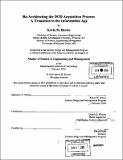| dc.contributor.advisor | Donna H. Rhodes. | en_US |
| dc.contributor.author | Brown, Kevin M., S.M. Massachusetts Institute of Technology | en_US |
| dc.contributor.other | System Design and Management Program. | en_US |
| dc.date.accessioned | 2006-11-07T13:38:57Z | |
| dc.date.available | 2006-11-07T13:38:57Z | |
| dc.date.copyright | 2006 | en_US |
| dc.date.issued | 2006 | en_US |
| dc.identifier.uri | http://hdl.handle.net/1721.1/34628 | |
| dc.description | Thesis (S.M.)--Massachusetts Institute of Technology, System Design and Management Program, 2006. | en_US |
| dc.description | Includes bibliographical references (p. 143-150). | en_US |
| dc.description.abstract | The military is the midst of significant change, due to the DoD transformation guidance and movement to Network-Centric Warfare/Operations. Unfortunately, both the guidance given, roadmaps produced and the level of espoused support for the transformation have caused fundamental change to occur slowly and at increasing expense. The military material development process was designed around a platform-centric system and worked well, but now the information age is causing a move to network-centric systems. This fundamental shift is not aligned with the DoD development process and reform will require broad changes in both organization and policy. This paper reviews the NCW Transformation goal, the DoD transformation guidance and compares them to the Transformation Roadmaps of the Army, Navy and Air Force. These guidance documents are then compared with actual transformation changes and the associated factors effecting the change, using J. Forrester type system dynamics models. The systems dynamics analysis studies numerous transformation factors for their effects and yields recommended alternative development architecture. | en_US |
| dc.description.abstract | (cont.) The goal of the paper is to align the DoD development process with the transformation guidance goals to result in a process which speeds prototype testing, development and fielding of new military systems, while integrating state-of-the-art business practice and theory. This resulted in the creation of several models which describe the various acquisition systems and a new model which addresses the issues found in the other models. The new model represents a reconfigured architecture for the DoD acquisitions system and a new organization to implement the transformation. | en_US |
| dc.description.statementofresponsibility | by Kevin M. Brown. | en_US |
| dc.format.extent | 150 p. | en_US |
| dc.format.extent | 9807385 bytes | |
| dc.format.extent | 9815676 bytes | |
| dc.format.mimetype | application/pdf | |
| dc.format.mimetype | application/pdf | |
| dc.language.iso | eng | en_US |
| dc.publisher | Massachusetts Institute of Technology | en_US |
| dc.rights | M.I.T. theses are protected by copyright. They may be viewed from this source for any purpose, but reproduction or distribution in any format is prohibited without written permission. See provided URL for inquiries about permission. | en_US |
| dc.rights.uri | http://dspace.mit.edu/handle/1721.1/7582 | |
| dc.subject | System Design and Management Program. | en_US |
| dc.title | Re-Architecting the DoD acquisition process : a transition to the information age | en_US |
| dc.title.alternative | Re-Architecting the Department of Defense acquisition process : a transition to the information age | en_US |
| dc.type | Thesis | en_US |
| dc.description.degree | S.M. | en_US |
| dc.contributor.department | System Design and Management Program. | en_US |
| dc.identifier.oclc | 71442155 | en_US |
